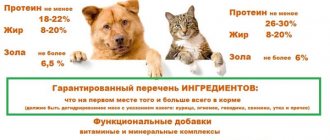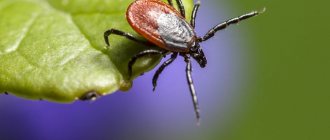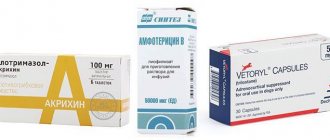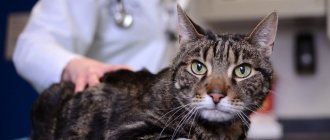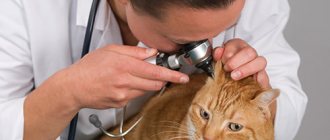Panleukopenia is one of the most dangerous acute viral diseases of cats. To protect your pet from illness and help him recover if he does get sick, you need to understand what processes occur in the animal’s body and what this disease is.
In everyday life, panleukopenia is called feline distemper, although it has nothing to do with the distemper virus
In this article we will explain what panleukopenia is and look at the main myths and facts associated with this disease.
Etiology of feline panleukopenia
- The causative agent of panleukopenia in cats - DNA - containing a virus of the Parvoviridae family
- Representatives of the feline, raccoon, civet, (mustelidae?) families are susceptible to panleukopenia.
- Virus tropism for actively dividing cells
- The virus can replicate in the thymus and lymphoid tissue of dogs
- Mutation of FPV to CPV, ability to infect cats is lost
- CPV-2 was isolated from leopards (an offshoot mutation)
- Confusion with nomenclature
- Representative of the Viverridae family - spotted lingsang
Pathogenesis
Because immune cells in the blood are attacked by various pathogens, this virus can lead to an anemic state and can open the body to infections from other diseases - viral or bacterial.
In the unvaccinated cat population, panleukopenia is one of the most fatal diseases. The causative virus is very stable and can survive for years in a contaminated environment, so the best preventive goal is to vaccinate the entire cat population.
Kittens between two and six months of age are at greatest risk of developing severe symptoms, as are pregnant and immunocompromised cats. In adult cats, panleukopenia is often milder and may even go unnoticed. Fortunately, cats that survive this infection are immune to any further infection by this virus. On the other hand, there are strains of the panleukopenia virus that provide almost 100% mortality.
What is enteritis
Enteritis is a viral disease characterized by inflammation of the intestinal epithelium. This disease most often chooses its “victim” among kittens. Therefore, it is so important not only to vaccinate young offspring on time, but also to monitor the hygiene of babies. Adults can also get sick, especially those cats whose immunity is weakened due to some disease, poor nutrition and unsatisfactory living conditions.
With enteritis, the intestinal mucosa becomes inflamed.
Important. Advanced enteritis is extremely difficult to cure. This can take a lot of time and effort, and even the most experienced and qualified doctor cannot guarantee a complete recovery.
Symptoms and signs of panleukopenia in cats
The gate of infection is the respiratory tract, gastrointestinal tract.
- Affects rapidly dividing cells: lymphoid tissue (bone marrow, thymus) – leukopenia; enterocytes – destruction of enterocytes – disturbance of maldigestion and malabsorption – diarrhea – dehydration, hypoalbuminemia, hypokalemia, hypoglycemia
- Factors complicating the course of panleukopenia: The presence of other gastrointestinal diseases: cystoisosporosis, helminthiasis, giardiasis, cryptosporidiosis, toxoplasmosis, clostridiosis, salmonellosis, eosinophilic, lymphocytic-plasmacytic infiltration of the mucous membrane, etc.; Poor feeding; Chronic viral infections.
- The incubation period for panleukopenia is 2-10 days
- Clinical signs of panleukopenia: at the beginning apathy, hyperthermia, anorexia, pain in the abdominal wall, prolapse of the third eyelid, then (2-5 days) hypothermia, vomiting, diarrhea, stupor, coma, death
Ataxia in kittens with panleukopenia
- Cause: infection of the placenta with a virus, transplacental infection of kittens, cerebellar hypoplasia, keratitis, hydrocephalus, hydroanencephaly, fetal death
What is important for your doctor to know?
Treating parvovirus symptoms in cats is difficult because they can resemble acute poisoning. It is important to collect anamnesis. Tell your doctor:
- When did you notice the first changes?
- When was the vaccine last given? Ideally, you should be treated by the doctor who administered the immunization.
- Character of stool.
- How long ago was the last treatment for helminths?
- What did you feed for the last two days?
If a friend in a nursery has become sick with all the livestock, poisoning is most likely occurring. If we are talking about infection, then the incubation period will be different for all cats. When making a diagnosis, it does not hurt to conduct research. But a laboratory is not always available, so the doctor has to act by elimination. That is, they carry out symptomatic treatment and, based on how the animal’s condition changes, draw a conclusion about what exactly caused the disease.
Unlike the plague, it is difficult to say in which area parvovirus is most common. In cats, it often appears if the animal walks freely and does not live in an apartment, if it does not have preventive vaccinations. In shelters, the number of cats is usually very large, so the likelihood of a sick animal appearing and infecting the rest is quite high.
Main signs and symptoms of feline panleukopenia
- Vomit
- Diarrhea/bloody diarrhea
- Dehydration
- Weight loss
- Heat
- Anemia (due to low red blood cells)
- Rough and disheveled fur
- Depression
- Complete loss of interest in food
- The cat is hiding
- Neurological symptoms (eg, lack of motor coordination)
- Causes of the disease (Etiology of panleukopenia in cats)
Feline parvovirus (FPV, causative agent of panleukopenia)
is the root cause of panleukopenia in cats. Cats acquire this infection when they come into contact with contaminated saliva, blood, feces, urine or other body fluids. The virus can also be transmitted by people who do not wash their hands properly or change clothes between contacts with cats or by materials such as bedding, food utensils or equipment that have been used on other cats.
Washing your hands with soap and water after handling any animal will minimize the chance of transmitting infection to healthy animals.
This virus can remain on many surfaces, so it is important to use safe and effective methods to prevent transmission of this disease. However, even in the cleanest conditions, small amounts of the virus may remain in the environment in which the infected cat was exposed. Feline parvovirus is resistant to disinfectants and can remain in the environment for up to a year, waiting to cause infection.
Kittens can contract the disease in the womb or through breast milk if the pregnant or nursing mother is exposed. As a rule, an unfavorable prognosis does not apply to those kittens that were exposed to this virus in the womb. They receive immunity for some time after birth (colostral immunity lasts about 14 days after stopping breastfeeding). Such kittens can also be exhibited in nurseries, pet stores, shelters and boarding schools.
Nutrition after illness: diet
After infection with enteritis, the animal must be fed according to its diet. You need to start feeding with great caution. Almost the entire gastrointestinal tract after enteritis is a continuous or not completely healed wound surface. Rough food will cause pain and discomfort to your pet. Also, hard and rough food will not be digested at all. Meals should be small and balanced. You can make up the diet yourself, or you can choose ready-made, non-dry food. Feeding fatty and sweet foods is prohibited. You need to stick to the diet for 4 weeks, in some cases for life.
In case of enteritis, a sick person is prescribed dietary table number 4 for 5 days, after which the diet is expanded, adhering to the basic requirements of dietary table number 5.
Diagnostics
Establishing diagnosis
- Comprehensively: life history data (contact with other cats, place of purchase, visit to a veterinary clinic, hospital treatment), vaccine history (colostral immunity, vaccination window), clinical signs, laboratory tests (general blood count, examination of feces or direct washings). intestines, nasopharyngeal swabs, blood for detection of the virus by PCR - may be false negative), ultrasound
- Blood tests
- White blood cell count less than 5,000
- Lymphopenia
- Thrombocytopenia
- Increased AST, ALT, bilirubin
- Azotemia (usually prerenal causes)
- Hypokalemia
- Hypoalbuminemia
- Hypoglycemia
- Laboratory error - both false negative and false positive information are possible
You will need to provide details about your cat's health and recent actions to your veterinarian. If your cat has recently come into contact with other cats or is going outside at all, it may be important to refer your veterinarian for a proper diagnosis.
Panleukopenia can mimic many other types of diseases
, including poisoning, feline leukemia (FeLV), feline immunodeficiency virus (FIV) and pancreatitis, intestinal and gastric foreign bodies, bacterial infections and helminthic infestations, among others, so it is important to give your veterinarian as much detail as possible so they can prescribe appropriate treatment .
Differential diagnoses for panleukopenia
- Leukemia
- Lymphoma
- Acute poisoning
- Foreign body of the gastrointestinal tract
- Sepsis
Your doctor will then perform a physical examination with routine laboratory tests, including a complete blood count, serum chemistry profile, and urinalysis. Laboratory test results are usually nonspecific, but a significant loss of white blood cells (leukocytopenia) will indicate panleukopenia to your veterinarian.
Feline parvovirus attacks and kills cells that divide rapidly, such as those produced in the bone marrow and intestines, so blood tests usually show a decrease in the number of white cells (leukocytes) and red blood cells.
Diagnosis
The veterinarian takes the animal's feces or intestinal scrapings for analysis. Today there are techniques that make it possible to find in this material not only the virus, but also the antibodies that are secreted by the body in response to its introduction. If a litter of kittens is affected, an autopsy and culture of materials is performed. This is not only a diagnosis, but also a chance to develop a suitable diagnostic technique.
Before mating, it is necessary to take blood tests for both the cat and the cat. If specific antibodies are detected in it, then the animal is a carrier of the virus. He is excluded from breeding.
Treatment of cats with panleukopenia
Sick cats require immediate treatment and often hospitalization. The first main goal of treatment is to restore body fluid levels and electrolyte balance. Specific treatment will depend on the severity of your cat's illness, but it will likely involve hospitalization for several days in an isolation facility to prevent it from spreading to other animals. Since in cats with panleukopenia the immune system practically does not work, sepsis occurs. Therefore, veterinarians prescribe broad-spectrum antibiotics for panleukopenia, usually intravenously.
What is the treatment strategy for panleukopenia in cats?
- Infusion therapy, electrolyte balance monitoring
- Broad-spectrum antibiotics (cefazolin, amoxicillin)
- Parenteral nutrition
- Beta-leukine, roncoleukin, interferon (virbagen), interferon inducers (cycloferon)
- Blood transfusion of a cat that has been vaccinated or has recovered from panleukopenia
- Antiemetics (thiethylperazine, metoclopramide), antispasmodics, thiamine and other B vitamins (prevention of thiamine deficiency)
- Oral bismuth preparations
- Anticholinergic drugs are contraindicated (platifillin) lead to dynamic intestinal obstruction
- Heparin for suspected disseminated intravascular coagulation
- Complications: DIC syndrome with endotoxemia; Ataxia, fetal myocarditis
- Immunity is strong
- Virus shedding after illness can last up to six months
Good supportive care can mean the difference between life and death. Once your cat returns home from the hospital, you will need to isolate her from other cats until all symptoms have resolved and your veterinarian gives the OK. This may take up to 6 weeks.
This infection has a particularly depressing effect on the physical and mental health of the cat. Your cat will need affection and comfort during the recovery period. It goes without saying that you will need to maintain strict hygiene, and given that this infection can remain on surfaces, be especially clean and careful after handling a sick cat so that you do not inadvertently spread the virus to other cats.
If your cat is treated quickly and effectively, he can make a full recovery. It may take several weeks for your cat to fully recover. Unfortunately, the mortality rate from panleukopenia reaches 90%.
Risk factors for the disease
There are several factors that increase the risk of contracting panleukopenia:
- Age up to one year and over 6 years. Most often, newborns, slightly older and elderly individuals get sick. This is due to the fact that the animal’s immunity at a young age is not yet fully formed, and at an older age, on the contrary, it is already weakened.
- Warm season. Outbreaks of the disease occur in spring and summer.
- Living in a house with 2 or more cats. If there are several cats in the house, the risk of contracting panleukopenia increases. It is quite difficult to isolate a sick cat in an apartment from other pets. And even after recovery, the animal remains infectious for 1–2 months.
- High contagiousness (infectiousness) of the disease. Parvovirus is very viable. That is why you need to be very careful when visiting various exhibitions, competitions, veterinary clinics, pet hotels and other places where animals gather with your cat.
- Unscrupulous breeders. They take the kittens away from their mother too early, so the babies do not have time to gain immunity from her milk. In addition, such breeders do not give any vaccinations to their pets for sale. Purchasing a cat from an unverified person is a huge risk.
Prevention and control measures for feline panleukopenia
Follow your veterinarian's instructions regarding drug administration, household disinfection, and the need for quarantine. If you have other cats, you will need to monitor them closely for signs of illness. Consult your veterinarian about the possibility of vaccinating other cats at home.
Anything your cat touches should be deeply cleaned and disinfected. Anything that can be washed and dried in a washing machine should be washed, and anything that can be washed in a dishwasher should be washed in a washing machine. This includes bedding, toys, dishes and trays, and a trash can.
Again, keep in mind that even then, you may not be able to remove all traces of the virus. Although your cat will not be susceptible to re-infection after recovery, other visiting cats may still be infected by contaminants that were left behind. You can also infect your friends' cats if you visit them.
Vaccination of cats is the most important means of preventing panleukopenia.
Before you bring a new kitten into your home, find out if it has been vaccinated. Fortunately, the vaccine is so effective that just one dose prevents most cases of panleukopenia virus infections. Be alert for any signs of illness, especially in young kittens, and ask your veterinarian to examine your pet as soon as possible if you notice anything of concern.
How to feed correctly
The first day a hunger strike is necessary, although in most cases cats do not require food. On the second and third days you need to give oatmeal with meat broth. Fiber helps the irritated walls of the stomach and intestines recover faster. On the fourth day, it is allowed to introduce minced meat. In general, it is recommended to keep your pet on soft food for a week, then return to its normal diet.
Attention! The key to a cat’s health is proper feeding, not only during illness. A sudden change in food can lead to gastroenteritis. The cat's gastrointestinal tract reacts sensitively to a new diet, especially if it is replaced by low-quality food.
Good to know
- Trichopolum instructions for veterinary medicine
- Instructions for the use of the antibiotic Baytril in animals
- Instructions for use of metronide
- Instructions for ceftriaxone preparations for animals
- Use of Metrogyl in veterinary medicine
- Instructions for doxycycline in animals
- Metronidazole (Metronidazole) for animals (instructions for use in veterinary medicine, doses, indications and contraindications)
- Atovaquone (ATOVAQUONE)
- Azithromycin, instructions for animal therapy
Consequences
As a result of a viral disease, the animal's liver and pancreas may be damaged. Inflammation spreads very quickly, and the pathological condition can be prevented by following a diet.
If an animal with enteritis is not treated, adhesions, obstruction and rupture of the intestinal walls may appear, which can lead to the development of peritonitis.
